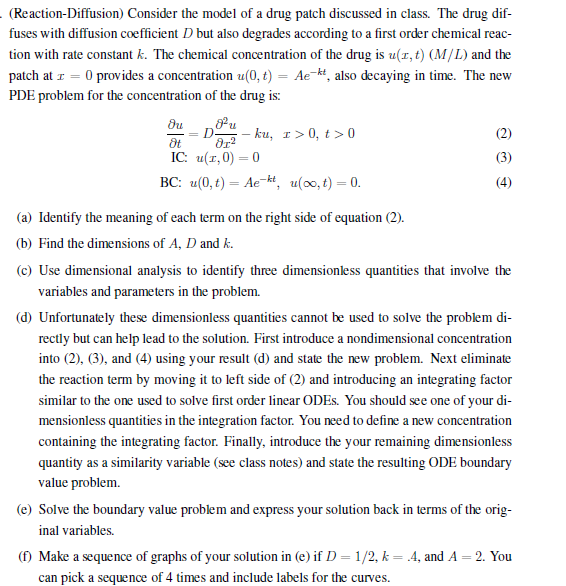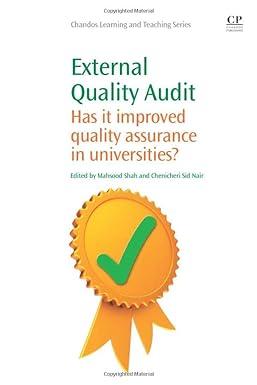
(Reaction-Diffusion) Consider the model of a drug patch discussed in class. The drug dif- fuses with diffusion coefficient D but also degrades according to a first order chemical reac- tion with rate constant k. The chemical concentration of the drug is u(1,t) (M/L) and the patch at I = 0 provides a concentration u(0,t) = Ae-kt, also decaying in time. The new PDE problem for the concentration of the drug is: Ou - ku, I>0, t > 0 at Ora IC: u(1,0) = 0 BC: u(0,t) = Ae-kt, u00, t) = 0. (2) (3) (a) Identify the meaning of each term on the right side of equation (2). (b) Find the dimensions of A, D and k. (c) Use dimensional analysis to identify three dimensionless quantities that involve the variables and parameters in the problem. (d) Unfortunately these dimensionless quantities cannot be used to solve the problem di- rectly but can help lead to the solution. First introduce a nondimensional concentration into (2), (3), and (4) using your result (d) and state the new problem. Next eliminate the reaction term by moving it to left side of (2) and introducing an integrating factor similar to the one used to solve first order linear ODEs. You should see one of your di- mensionless quantities in the integration factor. You need to define a new concentration containing the integrating factor. Finally, introduce the your remaining dimensionless quantity as a similarity variable (see class notes) and state the resulting ODE boundary value problem. (e) Solve the boundary value problem and express your solution back in terms of the orig- inal variables. (1) Make a sequence of graphs of your solution in (e)if D=1/2, k = 4, and A 2. You can pick a sequence of 4 times and include labels for the curves. (Reaction-Diffusion) Consider the model of a drug patch discussed in class. The drug dif- fuses with diffusion coefficient D but also degrades according to a first order chemical reac- tion with rate constant k. The chemical concentration of the drug is u(1,t) (M/L) and the patch at I = 0 provides a concentration u(0,t) = Ae-kt, also decaying in time. The new PDE problem for the concentration of the drug is: Ou - ku, I>0, t > 0 at Ora IC: u(1,0) = 0 BC: u(0,t) = Ae-kt, u00, t) = 0. (2) (3) (a) Identify the meaning of each term on the right side of equation (2). (b) Find the dimensions of A, D and k. (c) Use dimensional analysis to identify three dimensionless quantities that involve the variables and parameters in the problem. (d) Unfortunately these dimensionless quantities cannot be used to solve the problem di- rectly but can help lead to the solution. First introduce a nondimensional concentration into (2), (3), and (4) using your result (d) and state the new problem. Next eliminate the reaction term by moving it to left side of (2) and introducing an integrating factor similar to the one used to solve first order linear ODEs. You should see one of your di- mensionless quantities in the integration factor. You need to define a new concentration containing the integrating factor. Finally, introduce the your remaining dimensionless quantity as a similarity variable (see class notes) and state the resulting ODE boundary value problem. (e) Solve the boundary value problem and express your solution back in terms of the orig- inal variables. (1) Make a sequence of graphs of your solution in (e)if D=1/2, k = 4, and A 2. You can pick a sequence of 4 times and include labels for the curves







